Understanding Terrestrial Water Storage Changes Derived from the GRACE/GRACE-FO in the Inner Niger Delta in West Africa
Abstract
1. Introduction
2. Study Area
3. Data and Methodology
3.1. Data
3.2. Methodology
4. Results and Discussion
4.1. Analysis of TWS Changes
4.2. Analysis of TWS Changes Across Sub-Regions
4.3. Relationship Between TWS and Water Budget
4.4. Effect of Surface Water Bodies on TWS Variations
4.5. Effect of Groundwater Recharge on TWS Variations
5. Conclusions
- Monthly TWS exhibited seasonal variations from −170 mm to 330 mm, with a positive trend over the study period. Maximum TWS changes occurred in September, while minimum values were recorded in April–May.
- GRACE/GRACE-FO and GLDAS data showed a strong correlation in the IND (r = 0.92, RMSE = 35 mm), with sub-region correlations ranging from 0.87 to 0.93.
- Wavelet analysis indicated that most of the shared variance between GRACE/GRACE-FO and GLDAS TWS changes occurred at seasonal timescales of 8 to 16 months.
- The water budget (P-PE) influenced TWS variations only in humid areas near the Niger River’s source in Guinea, with no significant correlation in the semi-arid savanna and Sahelian IND regions.
- Groundwater recharge was the dominant driver of TWS changes in semi-arid and Sahelian regions, explaining 58–78% of TWS variance (r > 0.76).
- Surface water bodies significantly influenced TWS variations across the savanna areas along the Guinea–Mali border, particularly in Northern Guinea and southern Mali (r = 0.68).
Author Contributions
Funding
Data Availability Statement
Conflicts of Interest
References
- Tapley, B.D.; Bettadpur, S.; Watkins, M.; Reigber, C. The gravity recovery and climate experiment: Mission overview and early results. Geophys. Res. Lett. 2004, 31, L09607. [Google Scholar] [CrossRef]
- Famiglietti, J.S.; Rodell, M. Water in the balance. Science 2013, 340, 1300–1301. [Google Scholar] [CrossRef] [PubMed]
- Khorrami, B.; Ali, S.; Abadi, L.H.; Jehanzaib, M. Spatio-temporal variations in characteristics of terrestrial water storage and associated drought over different geographic regions of Türkiye. Earth Sci. Inform. 2022, 16, 717–731. [Google Scholar] [CrossRef]
- Deng, S.; Liu, S.; Mo, X. Assessment of three common methods for estimating terrestrial water storage change with three reanalysis datasets. J. Clim. 2020, 33, 511–525. [Google Scholar] [CrossRef]
- Landerer, F.W.; Swenson, S.C. Accuracy of scaled GRACE terrestrial water storage estimates. Water Resour. Res. 2012, 48, 1–11. [Google Scholar] [CrossRef]
- Fatolazadeh, F.; Goïta, K. Mapping terrestrial water storage changes in Canada using GRACE and GRACE-FO. Sci. Total Environ. 2021, 779, 146435. [Google Scholar] [CrossRef]
- Khorrami, B.; Gündüz, O. Remote sensing-based monitoring and evaluation of the basin-wise dynamics of terrestrial water and groundwater storage fluctuations. Environ. Monit. Assess. 2023, 195, 868. [Google Scholar] [CrossRef]
- Sun, Z.; Long, D.; Yang, W.; Li, X.; Pan, Y. Reconstruction of GRACE data on changes in total water storage over the global land surface and 60 basins. Water Resour. Res. 2020, 56, e2019WR026250. [Google Scholar] [CrossRef]
- Zwarts, L.; van Beukering, P.; Kone, B.; Wymenga, E. The Niger, a Lifeline: Water Management in the Inner Niger Delta in Mali; Wetlands International: Wageningen, The Netherlands, 2005. [Google Scholar]
- Werth, S.; White, D.; Bliss, D.W. GRACE detected rise of groundwater in the Sahelian Niger River basin. J. Geophys. Res. Solid Earth 2017, 122, 10459–10477. [Google Scholar] [CrossRef]
- Barbosa, S.A.; Jones, N.L.; Williams, G.P.; Mamane, B.; Begou, J.; Nelson, E.J.; Ames, D.P. Exploiting earth observations to enable groundwater modeling in the data-sparse region of Goulbi Maradi, Niger. Remote Sens. 2023, 15, 5199. [Google Scholar] [CrossRef]
- Bibi, S.; Zhu, T.; Rateb, A.; Scanlon, B.R.; Kamran, M.A.; Elnashar, A.; Bennour, A.; Li, C. Benchmarking multimodel terrestrial water storage seasonal cycle against Gravity Recovery and Climate Experiment (GRACE) observations over major global river basins. Hydrol. Earth Syst. Sci. 2024, 28, 1725–1750. [Google Scholar] [CrossRef]
- Hassan, A.; Jin, S. Water storage changes and balances in Africa observed by GRACE and hydrologic models. Geodesy Geodyn. 2016, 7, 39–49. [Google Scholar] [CrossRef]
- Hasan, E.; Tarhule, A.; Zume, J.T.; Kirstetter, P.-E. +50 years of terrestrial hydroclimatic variability in Africa’s transboundary waters. Sci. Rep. 2019, 9, 12327. [Google Scholar] [CrossRef] [PubMed]
- Hinderer, J.; Team, G.; Pfeffer, J.; Boucher, M.; Nahmani, S.; De Linage, C.; Boy, J.-P.; Genthon, P.; Seguis, L.; Favreau, G.; et al. Land water storage changes from ground and space geodesy: First results from the GHYRAF (Gravity and Hydrology in Africa) experiment. Pure Appl. Geophys. 2011, 169, 1391–1410. [Google Scholar] [CrossRef]
- Lu, Y.; Dai, L.; Yan, G.; Huo, Z.; Chen, W.; Lan, J.; Zhang, C.; Xu, Q.; Deng, S.; Chen, J. Effects of various land utilization types on groundwater at different temporal scales: A case study of Huocheng plain, Xinjiang, China. Front. Environ. Sci. 2023, 11, 1225916. [Google Scholar] [CrossRef]
- Springer, A.; Lopez, T.; Owor, M.; Frappart, F.; Stieglitz, T. The role of space-based observations for groundwater resource monitoring over Africa. Surv. Geophys. 2023, 44, 123–172. [Google Scholar] [CrossRef]
- Barbosa, S.A.; Pulla, S.T.; Williams, G.P.; Jones, N.L.; Mamane, B.; Sanchez, J.L. Evaluating groundwater storage change and recharge using GRACE data: A case study of aquifers in Niger, West Africa. Remote Sens. 2022, 14, 1532. [Google Scholar] [CrossRef]
- Cools, J.; Innocenti, D.; O’brien, S. Lessons from flood early warning systems. Environ. Sci. Policy 2016, 58, 117–122. [Google Scholar] [CrossRef]
- Klop, E.; Sikkema, M.; Diawara, M.; Gado, A. Ecological Hotspots and Land Use Patterns in the Upper Niger Basin, Guinea. Altenburg & Wymenga Ecological Consultants. Available online: https://www.altwym.nl/wp-content/uploads/2020/05/Klop-cs-2019.-Hotspots-Upper-NIger-Basin-Guinea-def.pdf (accessed on 17 May 2019).
- Oguntunde, P.G.; Abiodun, B.J. The impact of climate change on the Niger River Basin hydroclimatology, West Africa. Clim. Dyn. 2012, 40, 81–94. [Google Scholar] [CrossRef]
- Andersen, I.; Dione, O.; Jarosewich-Holder, M.; Olivry, J.C.; Golitzen, K.G. The Niger River Basin: A Vision for Sustainable Management; Water P-Notes, 16; World Bank Group: Washington, DC, USA, 2005; Available online: http://documents.worldbank.org/curated/en/446841468290737812/The-Niger-river-basin-a-vision-for-sustainable-management (accessed on 1 October 2008).
- Schuol, J.; Abbaspour, K.C.; Srinivasan, R.; Yang, H. Estimation of freshwater availability in the West African sub-continent using the SWAT hydrologic model. J. Hydrol. 2008, 352, 30–49. [Google Scholar] [CrossRef]
- Dada, O.A.; Li, G.; Qiao, L.; Asiwaju-Bello, Y.A.; Anifowose, A.Y.B. Recent Niger Delta shoreline response to Niger River hydrology: Conflict between forces of nature and humans. J. Afr. Earth Sci. 2018, 139, 222–231. [Google Scholar] [CrossRef]
- Bonkoungou, B.; Bossa, A.Y.; van der Kwast, J.; Mul, M.; Sintondji, L.O. Inner Niger Delta inundation extent (2010–2022) based on Landsat imagery and the Google Earth Engine. Remote Sens. 2024, 16, 1853. [Google Scholar] [CrossRef]
- Thompson, J.R.; Crawley, A.; Kingston, D.G. Future river flows and flood extent in the Upper Niger and Inner Niger Delta: GCM-related uncertainty using the CMIP5 ensemble. Hydrol. Sci. J. 2017, 62, 2239–2265. [Google Scholar] [CrossRef]
- Yang, J.; Yang, Y.C.E.; Khan, H.F.; Xie, H.; Ringler, C.; Ogilvie, A.; Seidou, O.; Djibo, A.G.; van Weert, F.; Tharme, R. Quantifying the sustainability of water availability for the water-food-energy-ecosystem nexus in the Niger River Basin. Earth’s Futur. 2018, 6, 1292–1310. [Google Scholar] [CrossRef]
- Nicholson, S.E. The nature of rainfall variability over Africa on time scales of decades to millenia. Glob. Planet. Change 2000, 26, 137–158. [Google Scholar] [CrossRef]
- Mahmood, R.; Jia, S.; Zhu, W. Analysis of climate variability, trends, and prediction in the most active parts of the Lake Chad basin, Africa. Sci. Rep. 2019, 9, 6317. [Google Scholar] [CrossRef]
- Kornfeld, R.P.; Arnold, B.W.; Gross, M.A.; Dahya, N.T.; Klipstein, W.M.; Gath, P.F.; Bettadpur, S. GRACE-FO: The Gravity Recovery and Climate Experiment Follow-On Mission. J. Spacecr. Rocket. 2019, 56, 931–951. [Google Scholar] [CrossRef]
- Vörösmarty, C.J.; McIntyre, P.B.; Gessner, M.O.; Dudgeon, D.; Prusevich, A.; Green, P.; Glidden, S.; Bunn, S.E.; Sullivan, C.A.; Liermann, C.R.; et al. Global threats to human water security and river biodiversity. Nature 2010, 467, 555–561. [Google Scholar] [CrossRef]
- Chen, J.; Cazenave, A.; Dahle, C.; Llovel, W.; Panet, I.; Pfeffer, J.; Moreira, L. Applications and challenges of GRACE and GRACE Follow-On satellite gravimetry. Surv. Geophys. 2022, 43, 305–345. [Google Scholar] [CrossRef]
- Fatolazadeh, F.; Eshagh, M.; Goïta, K. New spectro-spatial downscaling approach for terrestrial and groundwater storage variations estimated by GRACE models. J. Hydrol. 2022, 615, 128635. [Google Scholar] [CrossRef]
- Fatolazadeh, F.; Eshagh, M.; Goïta, K.; Wang, S. A New Spatiotemporal Estimator to Downscale GRACE Gravity Models for Terrestrial and Groundwater Storage Variations Estimation. Remote Sens. 2022, 14, 5991. [Google Scholar] [CrossRef]
- Rodell, M.; Houser, P.R.; Jambor, U.; Gottschalck, J.; Mitchell, K.; Meng, C.-J.; Arsenault, K.; Cosgrove, B.; Radakovich, J.; Bosilovich, M.; et al. The global land data assimilation system. Bull. Am. Meteorol. Soc. 2004, 85, 381–394. [Google Scholar] [CrossRef]
- Li, B.; Rodell, M.; Kumar, S.; Beaudoing, H.K.; Getirana, A.; Zaitchik, B.F.; de Goncalves, L.G.; Cossetin, C.; Bhanja, S.; Mukherjee, A.; et al. Global GRACE data assimilation for groundwater and drought monitoring: Advances and challenges. Water Resour. Res. 2019, 55, 7564–7586. [Google Scholar] [CrossRef]
- Li, B.; Beaudoing, H.; Rodell, M. GLDAS Catchment Land Surface Model L4 Daily 0.25 × 0.25 Degree GRACE-DA1 V2; Goddard Earth Sciences Data and Information Services Center (GES DISC): Greenbelt, MD, USA, 2020. [CrossRef]
- Schmied, H.M.; Cáceres, D.; Eisner, S.; Flörke, M.; Herbert, C.; Niemann, C.; Peiris, T.A.; Popat, E.; Portmann, F.T.; Reinecke, R.; et al. The global water resources and use model WaterGAP v2.2d: Model description and evaluation. Geosci. Model Dev. 2021, 14, 1037–1079. [Google Scholar] [CrossRef]
- Díaz-Alcaide, S.; Martínez-Santos, P.; Villarroya, F. A commune-level groundwater potential map for the Republic of Mali. Water 2017, 9, 839. [Google Scholar] [CrossRef]
- Onyekuru, N.A.; Marchant, R.; Touza, J.M.; Ume, C.; Chiemela, C.; Onyia, C.; Eboh, E.C.; Eze, C.C. A–Z of cost-effective adaptation strategies to the impact of climate change among crop farmers in West Africa. Environ. Dev. Sustain. 2023, 26, 20311–20332. [Google Scholar] [CrossRef]
- Biancamaria, S.; Mballo, M.; Le Moigne, P.; Pérez, J.M.S.; Espitalier-Noël, G.; Grusson, Y.; Cakir, R.; Häfliger, V.; Barathieu, F.; Trasmonte, M.; et al. Total water storage variability from GRACE mission and hydrological models for a 50,000 km2 temperate watershed: The Garonne River basin (France). J. Hydrol. Reg. Stud. 2019, 24, 100609. [Google Scholar] [CrossRef]
- Jia, Y.; Lei, H.; Yang, H.; Hu, Q. Terrestrial water storage change retrieved by GRACE and its implication in the Tibetan Plateau: Estimating areal precipitation in ungauged regions. Remote Sens. 2020, 12, 3129. [Google Scholar] [CrossRef]
- Neves, M.C.; Nunes, L.M.; Monteiro, J.P. Evaluation of GRACE data for water resource management in Iberia: A case study of groundwater storage monitoring in the Algarve region. J. Hydrol. Reg. Stud. 2020, 32, 100734. [Google Scholar] [CrossRef]
- Nimmo, J.R.; Horowitz, C.; Mitchell, L. Discrete-storm water-table fluctuation method to estimate episodic recharge. Groundwater 2014, 53, 282–292. [Google Scholar] [CrossRef]
- Wu, Q.; Si, B.; He, H.; Wu, P. Determining regional-scale groundwater recharge with GRACE and GLDAS. Remote Sens. 2019, 11, 154. [Google Scholar] [CrossRef]
- Fatolazadeh, F.; Goïta, K. Reconstructing groundwater storage variations from GRACE observations using a new Gaussian-Han-Fan (GHF) smoothing approach. J. Hydrol. 2022, 604, 127234. [Google Scholar] [CrossRef]
- Li, F.; Kusche, J.; Rietbroek, R.; Wang, Z.; Forootan, E.; Schulze, K.; Lück, C. Comparison of data-driven techniques to reconstruct (1992–2002) and predict (2017–2018) GRACE-like gridded total water storage changes using climate inputs. Water Resour. Res. 2020, 56, e2019WR026551. [Google Scholar] [CrossRef]
- Tangdamrongsub, N. Comparative analysis of global terrestrial water storage simulations: Assessing CABLE, Noah-MP, PCR-GLOBWB, and GLDAS performances during the GRACE and GRACE-FO era. Water 2023, 15, 2456. [Google Scholar] [CrossRef]
- Henry, C.; Allen, D.M.; Kirste, D. Characterizing recharge in southern Mali using a combination of modeling and stable isotopes. Front. Water 2022, 4, 778957. [Google Scholar] [CrossRef]
- Johnston, R.; Smakhtin, V. Hydrological modeling of large river basins: How much is enough? Water Resour. Manag. 2014, 28, 2695–2730. [Google Scholar] [CrossRef]
- Li, F.; Kusche, J.; Chao, N.; Wang, Z.; Löcher, A. Long-term (1979–present) total water storage anomalies over the global land derived by reconstructing GRACE data. Geophys. Res. Lett. 2021, 48, e2021GL093492. [Google Scholar] [CrossRef]
- Fatolazadeh, F.; Eshagh, M.; Goïta, K. A new approach for generating optimal GLDAS hydrological products and uncertainties. Sci. Total Environ. 2020, 730, 138932. [Google Scholar] [CrossRef]
- Descroix, L.; Mahé, G.; Lebel, T.; Favreau, G.; Galle, S.; Gautier, E.; Olivry, J.-C.; Albergel, J.; Amogu, O.; Cappelaere, B.; et al. Spatio-temporal variability of hydrological regimes around the boundaries between Sahelian and Sudanian areas of West Africa: A synthesis. J. Hydrol. 2009, 375, 90–102. [Google Scholar] [CrossRef]
- Seka, A.M.; Zhang, J.; Ayele, G.T.; Demeke, Y.G.; Han, J.; Prodhan, F.A. Spatio-temporal analysis of water storage variation and temporal correlations in the East Africa lake basins. J. Hydrol. Reg. Stud. 2022, 41, 101094. [Google Scholar] [CrossRef]
- Cuthbert, M.O.; Taylor, R.G.; Favreau, G.; Todd, M.C.; Shamsudduha, M.; Villholth, K.G.; MacDonald, A.M.; Scanlon, B.R.; Kotchoni, D.O.V.; Vouillamoz, J.-M.; et al. Observed controls on resilience of groundwater to climate variability in sub-Saharan Africa. Nature 2019, 572, 230–234. [Google Scholar] [CrossRef] [PubMed]
- Sur, K.; Verma, V.K.; Pateriya, B. Surface water estimation at regional scale using hybrid techniques in GEE environment-A case study on Punjab State of India. Remote Sens. Appl. Soc. Environ. 2021, 24, 100625. [Google Scholar] [CrossRef]
- Scanlon, B.R.; Zhang, Z.; Save, H.; Wiese, D.N.; Landerer, F.W.; Long, D.; Longuevergne, L.; Chen, J. Global evaluation of new GRACE mascon products for hydrologic applications. Water Resour. Res. 2016, 52, 9412–9429. [Google Scholar] [CrossRef]
- Pavelic, P.; Giordano, M.; Keraita, B.N.; Ramesh, V.; Rao, T. Groundwater Availability and Use in Sub-Saharan Africa: A Review of 15 Countries; International Water Management Institute (IWMI): Colombo, Sri Lanka, 2012. [Google Scholar] [CrossRef]
- Taylor, R.G.; Scanlon, B.; Döll, P.; Rodell, M.; Van Beek, R.; Wada, Y.; Longuevergne, L.; Leblanc, M.; Famiglietti, J.S.; Edmunds, M.; et al. Ground water and climate change. Nat. Clim. Change 2013, 3, 322–329. [Google Scholar] [CrossRef]
- Ramillien, G.; Frappart, F.; Seoane, L. Application of the regional water mass variations from GRACE satellite gravimetry to large-scale water management in Africa. Remote Sens. 2014, 6, 7379–7405. [Google Scholar] [CrossRef]
- Syed, T.H.; Famiglietti, J.S.; Rodell, M.; Chen, J.; Wilson, C.R. Analysis of terrestrial water storage changes from GRACE and GLDAS. Water Resour. Res. 2008, 44, W02433. [Google Scholar] [CrossRef]
- Werth, S.; Güntner, A.; Petrovic, S.; Schmidt, R. Integration of GRACE mass variations into a global hydrological model. Earth Planet. Sci. Lett. 2009, 277, 166–173. [Google Scholar] [CrossRef]
- Scanlon, B.R.; Faunt, C.C.; Longuevergne, L.; Reedy, R.C.; Alley, W.M.; McGuire, V.L.; McMahon, P.B. Groundwater depletion and sustainability of irrigation in the US High Plains and Central Valley. Proc. Natl. Acad. Sci. USA 2012, 109, 9320–9325. [Google Scholar] [CrossRef]
- Ferreira, V.G.; Yang, H.; Ndehedehe, C.; Wang, H.; Ge, Y.; Xu, J.; Xia, M.; Kalu, I.; Jing, M.; Agutu, N. Estimating groundwater recharge across Africa during 2003–2023 using GRACE-derived groundwater storage changes. J. Hydrol. Reg. Stud. 2024, 56, 102046. [Google Scholar] [CrossRef]
- Rodell, M.; Famiglietti, J.S.; Wiese, D.N.; Reager, J.T.; Beaudoing, H.K.; Landerer, F.W.; Lo, M.-H. Emerging trends in global freshwater availability. Nature 2018, 557, 651–659. [Google Scholar] [CrossRef]
- Aeschbach-Hertig, W.; Gleeson, T. Regional strategies for the accelerating global problem of groundwater depletion. Nat. Geosci. 2012, 5, 853–861. [Google Scholar] [CrossRef]
- Pazola, A.; Shamsudduha, M.; French, J.; MacDonald, A.M.; Abiye, T.; Goni, I.B.; Taylor, R.G. High-resolution long-term average groundwater recharge in Africa estimated using random forest regression and residual interpolation. Hydrol. Earth Syst. Sci. 2024, 28, 2949–2967. [Google Scholar] [CrossRef]
- Turkeltaub, T.; Bel, G. Changes in mean evapotranspiration dominate groundwater recharge in semi-arid regions. Hydrol. Earth Syst. Sci. 2024, 28, 4263–4274. [Google Scholar] [CrossRef]
- Ndehedehe, C.E.; Adeyeri, O.E.; Onojeghuo, A.O.; Ferreira, V.G.; Kalu, I.; Okwuashi, O. Understanding global groundwater-climate interactions. Sci. Total Environ. 2023, 904, 166571. [Google Scholar] [CrossRef] [PubMed]
- Deng, S.; Liu, Y.; Zhang, W. A comprehensive evaluation of GRACE-like terrestrial water storage (TWS) reconstruction products at an interannual scale during 1981–2019. Water Resour. Res. 2023, 59, e2022WR034381. [Google Scholar] [CrossRef]
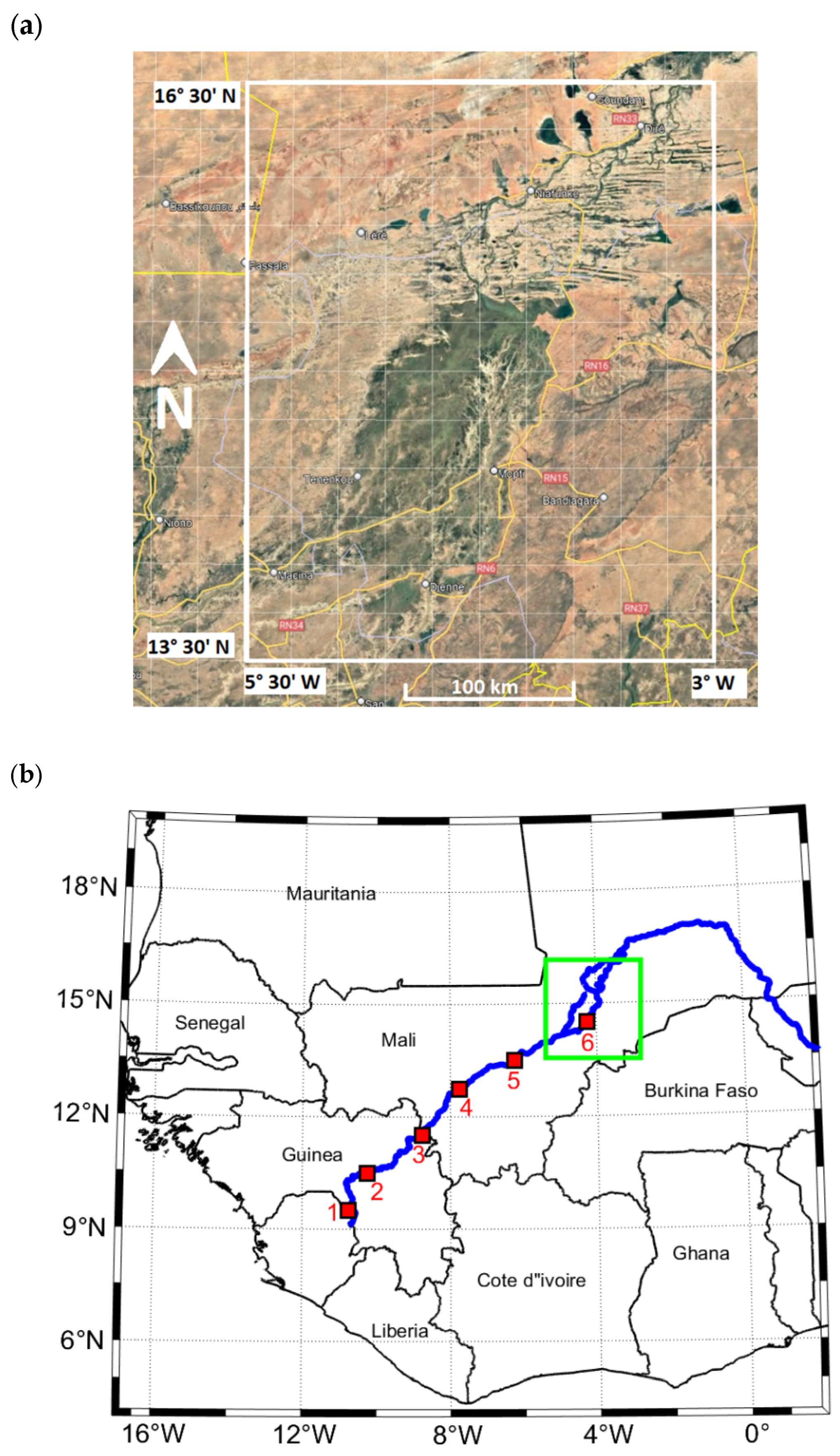
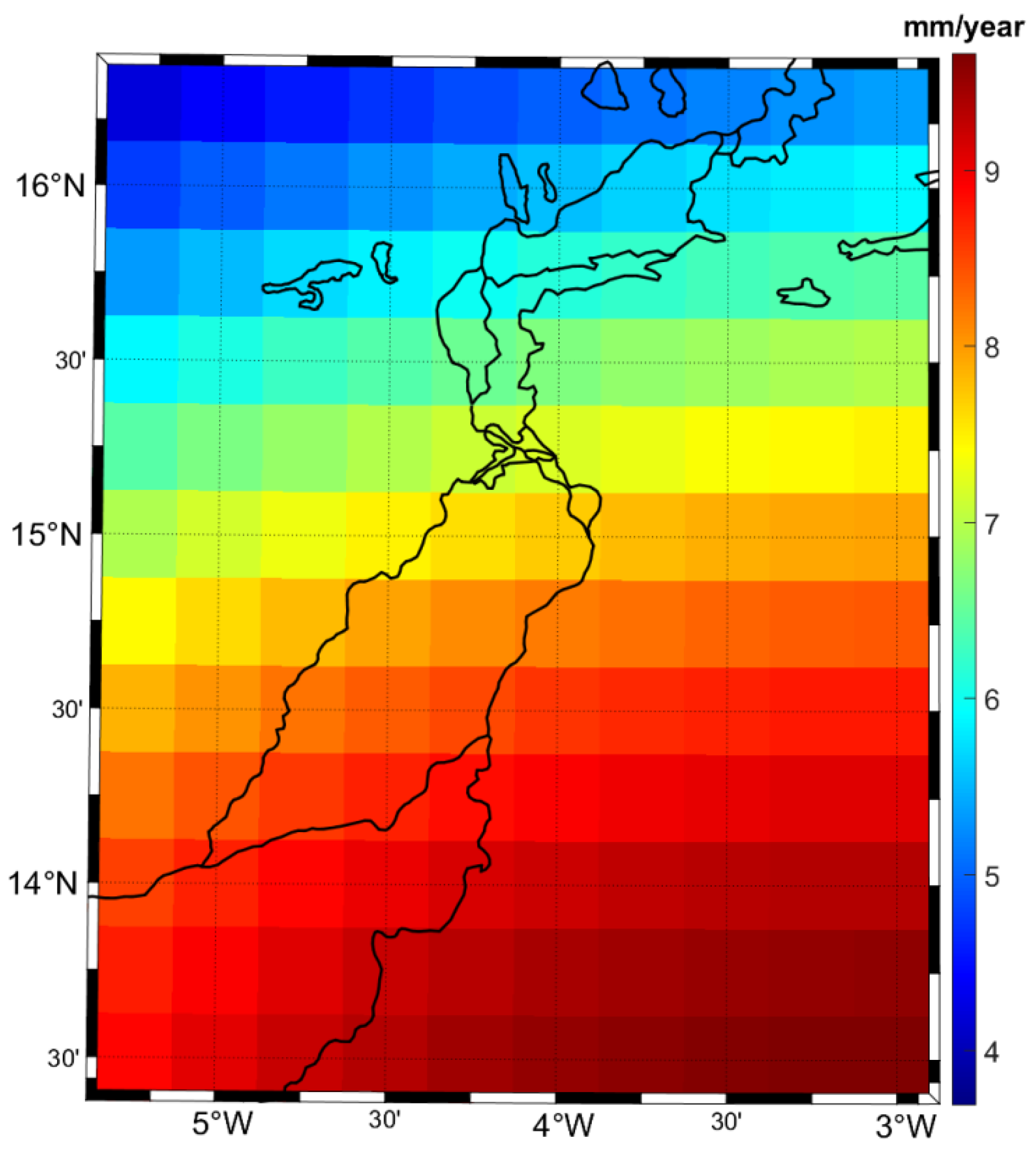


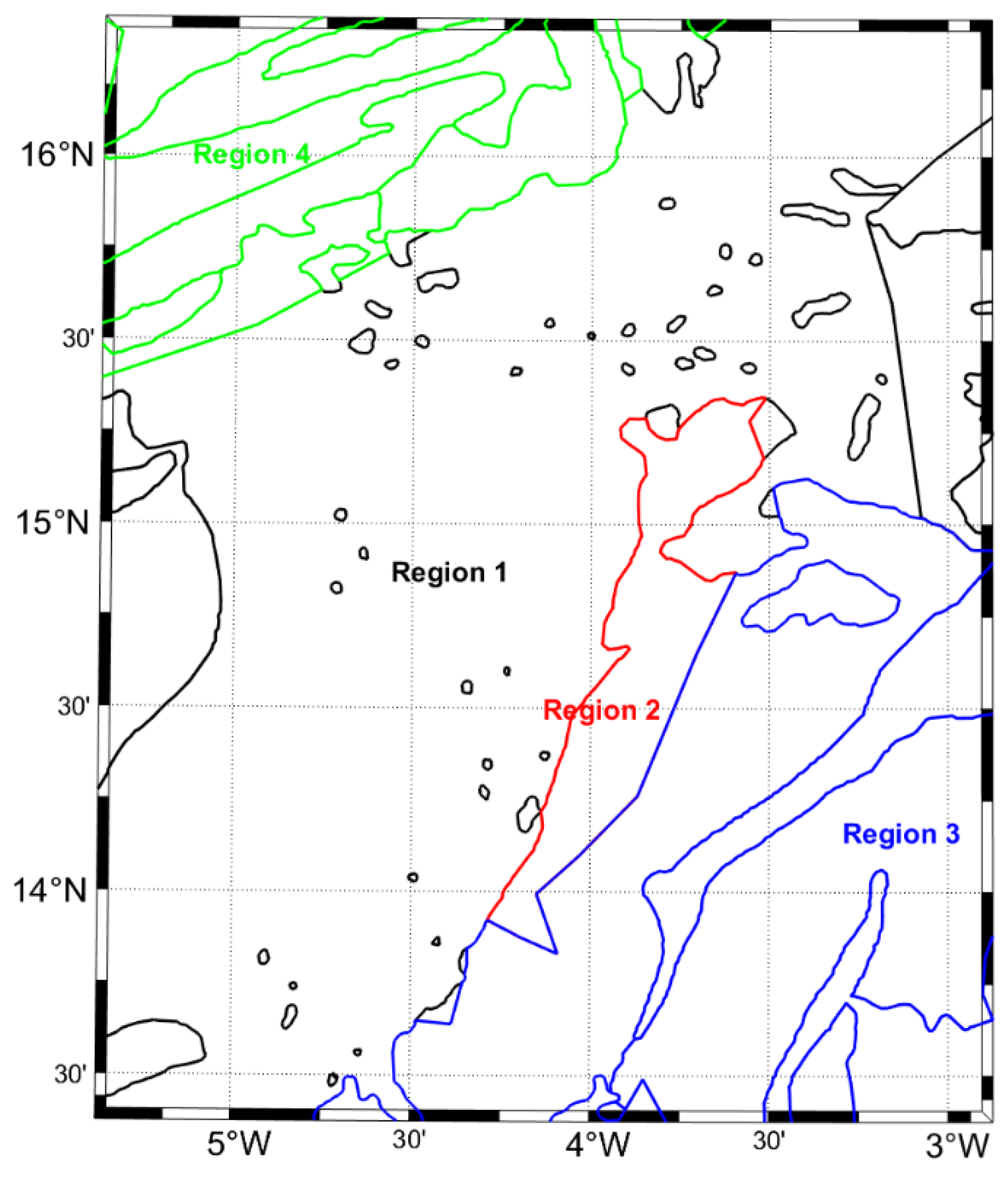
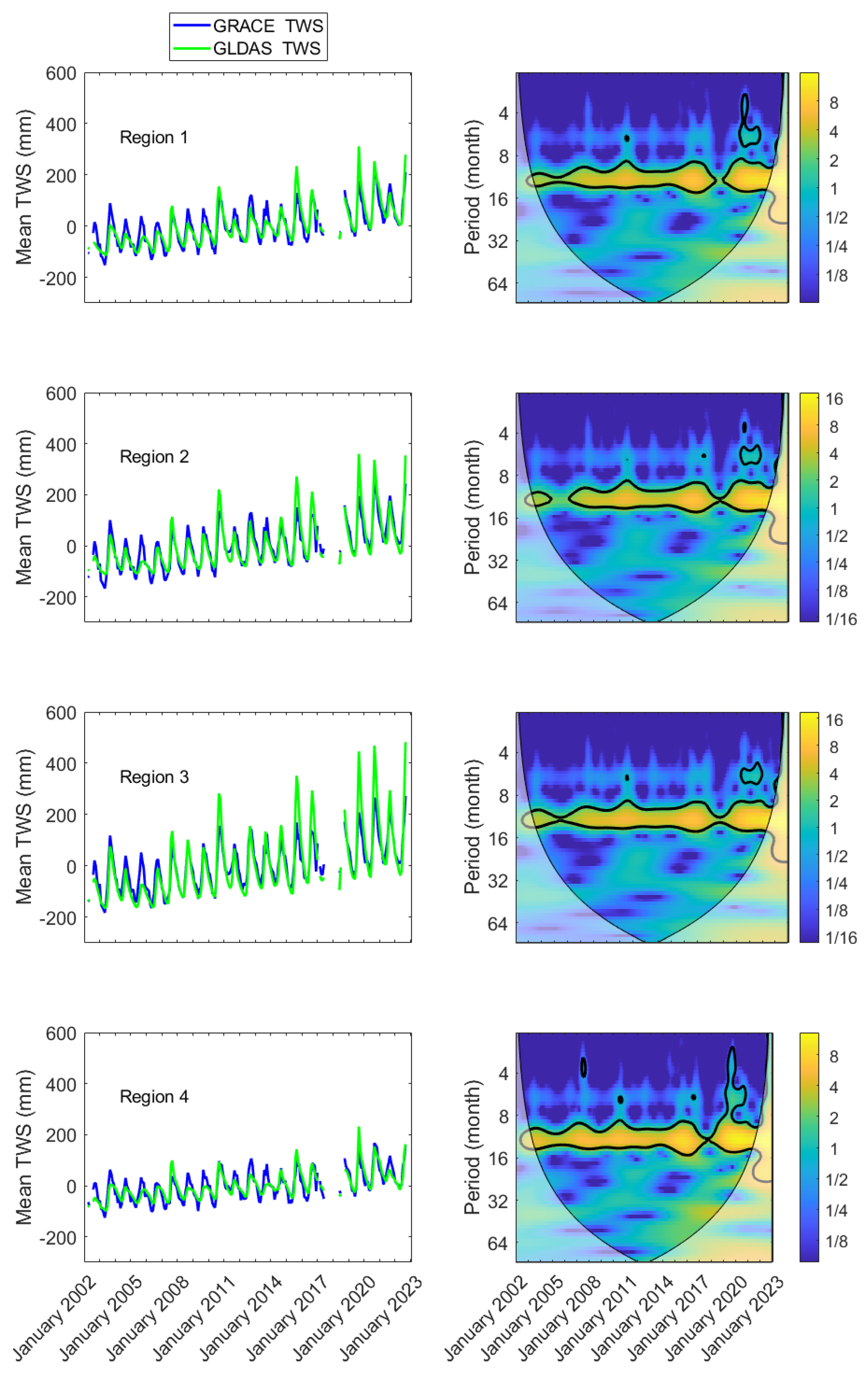


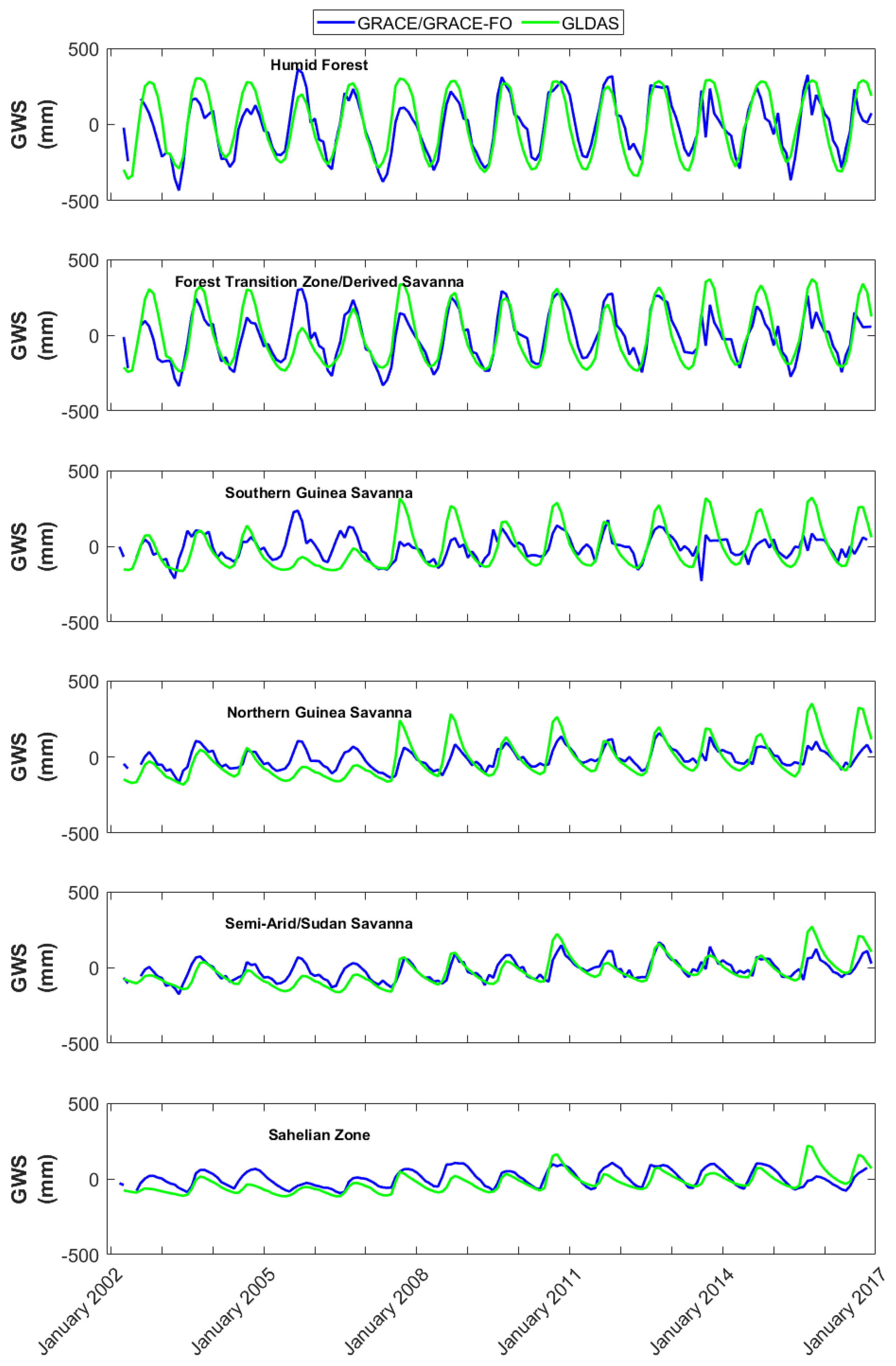
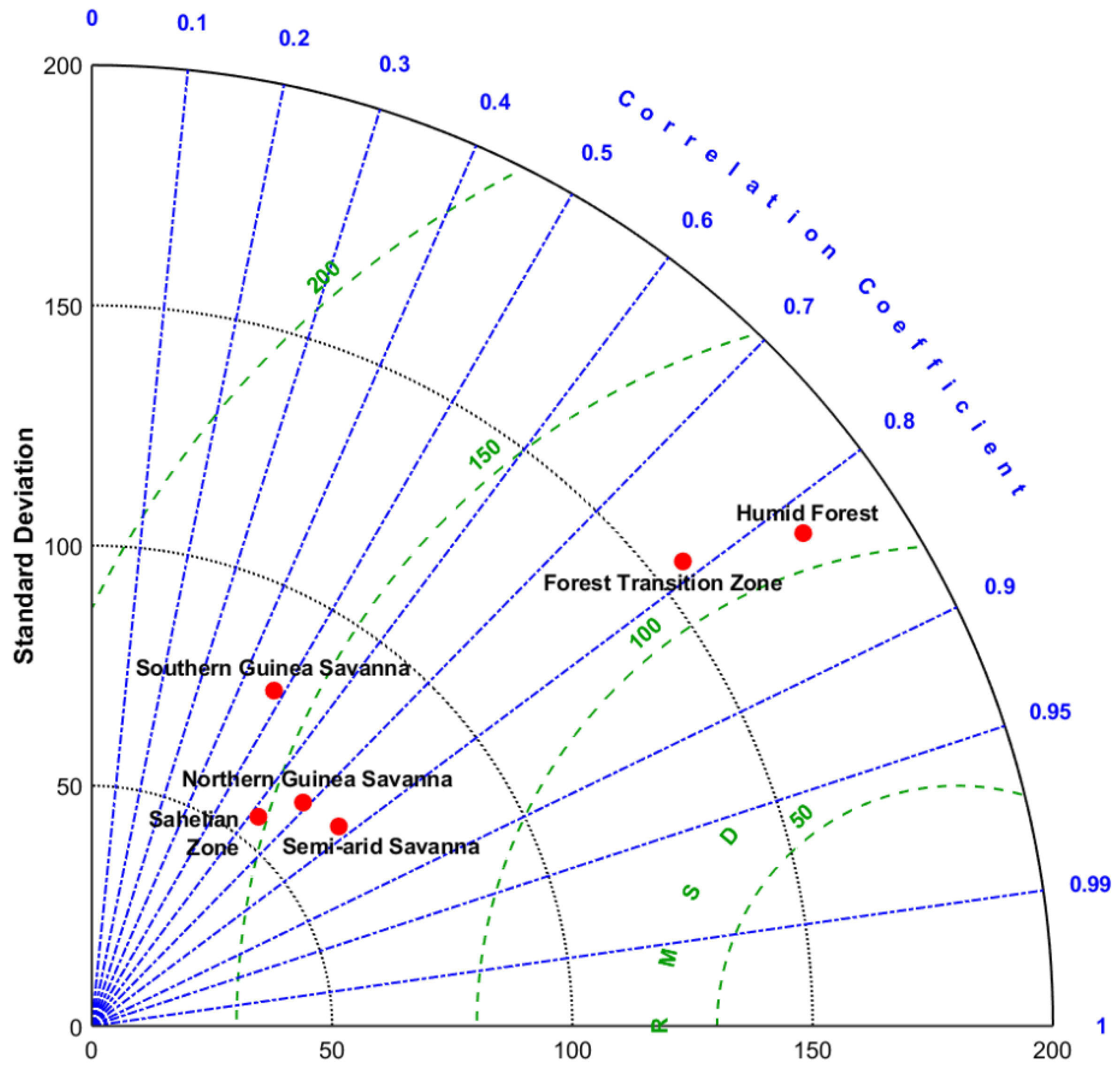
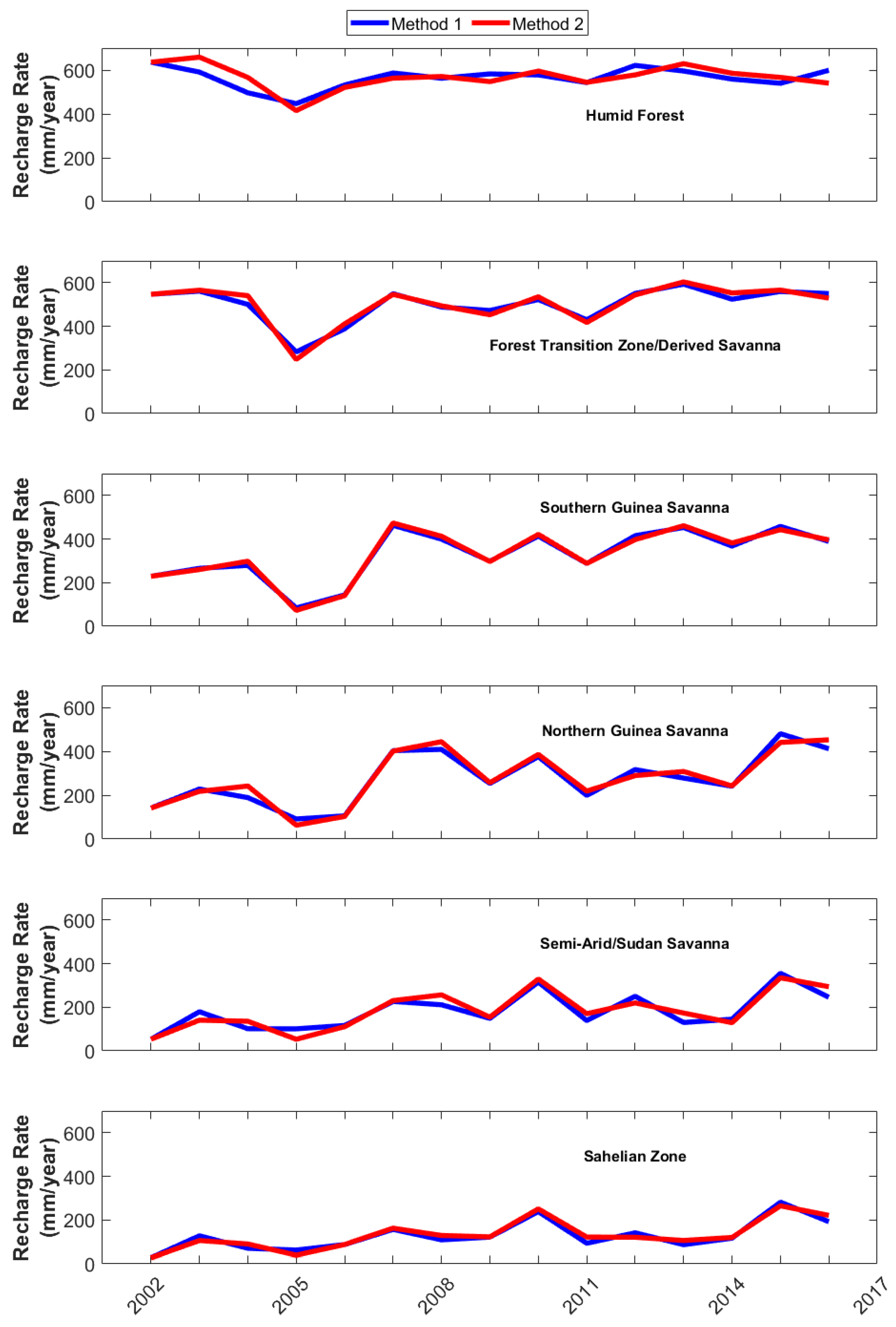
| Max TWS Variations (GRACE/GRACE-FO | Min TWS Variations (GRACE/GRACE-FO) | Max TWS Variations (GLDAS) | Min TWS Variations (GLDAS) | |
|---|---|---|---|---|
| 2002 | September | April | September | May |
| 2003 | September | May | September | May |
| 2004 | September | May | September | June |
| 2005 | September | May | November | May |
| 2006 | September | May | September | June |
| 2007 | September | March | September | June |
| 2008 | September | June | September | May |
| 2009 | September | May | September | May |
| 2010 | September | June | September | May |
| 2011 | September | May | September | June |
| 2012 | September | March | September | May |
| 2013 | October | May | September | June |
| 2014 | September | April | September | April |
| 2015 | September | April | September | May |
| 2016 | August | May | September | May |
| 2017 | Incomplete data | May | Incomplete data | April |
| 2018 | Incomplete data | Incomplete data | Incomplete data | Incomplete data |
| 2019 | September | June | September | May |
| 2020 | September | May | September | June |
| 2021 | September | April | September | June |
| 2022 | September | April | September | May |
| RMSE (mm) | Correlation | |
|---|---|---|
| Region 1 | 34.5 | 0.90 |
| Region 2 | 38.4 | 0.91 |
| Region 3 | 54.5 | 0.93 |
| Region 4 | 28.7 | 0.87 |
| Location | Eco-Climatic Zone | Latitude | Longitude | Correlation | RMSE (mm) | p-Value |
|---|---|---|---|---|---|---|
| 1 | Humid Forest | 9.500 | −10.750 | 0.26 | 124.6 | <10−4 |
| 2 | Forest Transition Zone/Derived Savanna | 10.500 | −10.250 | 0.25 | 110.3 | <10−3 |
| 3 | Southern Guinea Savanna | 11.500 | −8.750 | 0.18 | 103.4 | 0.0096 |
| 4 | Northern Guinea Savanna | 12.750 | −7.750 | 0.10 | 99.1 | 0.32 |
| 5 | Semi-Arid/Sudan Savanna | 13.500 | −6.250 | −0.06 | 95.8 | 0.40 |
| 6 | Sahelian Zone (IND) | 14.500 | −4.250 | −0.14 | 92 | 0.03 |
| Location | Climatic Zone | Correlation |
|---|---|---|
| 1 | Humid Forest | 0.39 |
| 2 | Forest Transition Zone/Derived Savanna | 0.54 |
| 3 | Southern Guinea Savanna | 0.69 |
| 4 | Northern Guinea Savanna | 0.67 |
| 5 | Semi-Arid/Sudan Savanna | 0.66 |
| 6 | Sahelian Zone | 0.51 |
| Location | Climatic Zone | Correlation | RMSE (mm) |
|---|---|---|---|
| 1 | Humid Forest | 0.83 | 120.6 |
| 2 | Forest Transition Zone/Derived Savanna | 0.79 | 115.8 |
| 3 | Southern Guinea Savanna | 0.48 | 118.3 |
| 4 | Northern Guinea Savanna | 0.69 | 87.4 |
| 5 | Semi-Arid/Sudan Savanna | 0.78 | 56.4 |
| 6 | Sahelian IND | 0.63 | 60.2 |
| Pixel Number | Climatic Zone | Method | Correlation | p-Value |
|---|---|---|---|---|
| 1 | Humid Forest | Method 1 | 0.47 | 0.09 |
| Method 2 | 0.29 | 0.33 | ||
| 2 | Forest Transition Zone/Derived Savanna | Method 1 | 0.59 | 0.02 |
| Method 2 | 0.53 | 0.05 | ||
| 3 | Southern Guinea Savanna | Method 1 | 0.74 | 0.002 |
| Method 2 | 0.73 | 0.003 | ||
| 4 | Northern Guinea Savanna | Method 1 | 0.74 | 0.002 |
| Method 2 | 0.76 | 0.002 | ||
| 5 | Semi-Arid/Sudan Savanna | Method 1 | 0.73 | 0.003 |
| Method 2 | 0.81 | 0.0005 | ||
| 6 | Sahelian Region | Method 1 | 0.78 | 0.0001 |
| Method 2 | 0.86 | 0.0001 |
Disclaimer/Publisher’s Note: The statements, opinions and data contained in all publications are solely those of the individual author(s) and contributor(s) and not of MDPI and/or the editor(s). MDPI and/or the editor(s) disclaim responsibility for any injury to people or property resulting from any ideas, methods, instructions or products referred to in the content. |
© 2025 by the authors. Licensee MDPI, Basel, Switzerland. This article is an open access article distributed under the terms and conditions of the Creative Commons Attribution (CC BY) license (https://creativecommons.org/licenses/by/4.0/).
Share and Cite
Fatolazadeh, F.; Goïta, K. Understanding Terrestrial Water Storage Changes Derived from the GRACE/GRACE-FO in the Inner Niger Delta in West Africa. Water 2025, 17, 1121. https://doi.org/10.3390/w17081121
Fatolazadeh F, Goïta K. Understanding Terrestrial Water Storage Changes Derived from the GRACE/GRACE-FO in the Inner Niger Delta in West Africa. Water. 2025; 17(8):1121. https://doi.org/10.3390/w17081121
Chicago/Turabian StyleFatolazadeh, Farzam, and Kalifa Goïta. 2025. "Understanding Terrestrial Water Storage Changes Derived from the GRACE/GRACE-FO in the Inner Niger Delta in West Africa" Water 17, no. 8: 1121. https://doi.org/10.3390/w17081121
APA StyleFatolazadeh, F., & Goïta, K. (2025). Understanding Terrestrial Water Storage Changes Derived from the GRACE/GRACE-FO in the Inner Niger Delta in West Africa. Water, 17(8), 1121. https://doi.org/10.3390/w17081121








